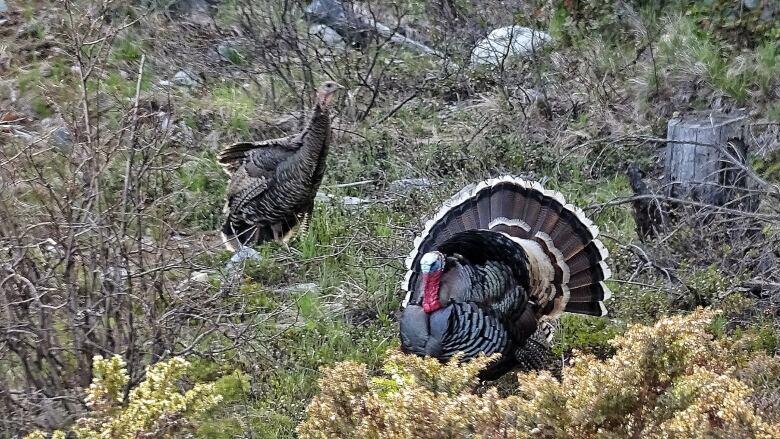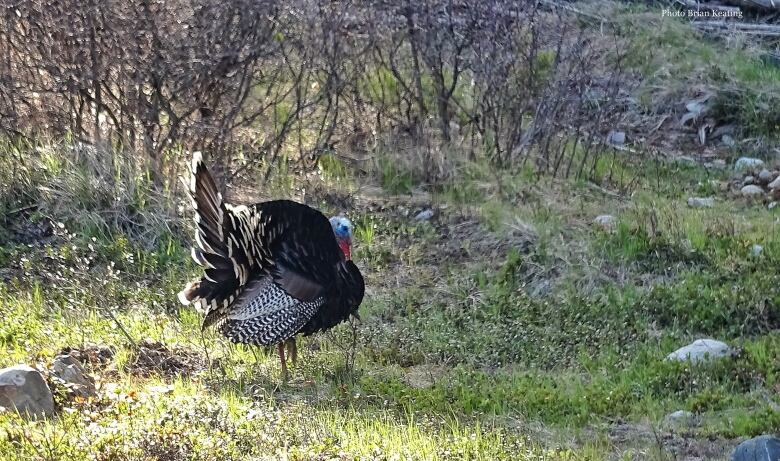Move over chicken dance, naturalist Brian Keating explains the wild turkey dance
Wild turkeys can be found near Porcupine Hills and Cypress Hills in Alberta

Recently, Calgary-based naturalist Brian Keating and his wife had a front row seat to one of nature's most peculiar phenomena: The dance of the wild turkey.
Slowly turning like a ballerina, the male turkey showed off for two female turkeys just off the Rocky Mountain trench in B.C., not far from Cranbrook.
Keating and his wife had pulled about five kilometres off the main highway, on their way to a recreation site, before noticing the roadside entertainment.
"Fortunately, we spotted the birds before we got very close, so we didn't disturb them," Keating said.
"There is no question they heard and saw my truck, but the male must have been full of testosterone, as he kept on doing what he's programmed to do at this time of year!"
All backlit with the low western sun illuminating his tail feathers, the wild turkey continued to show off his strut and stature.
"The male essentially puffed himself up into a feathery ball, and several times, he stretched his neck out and let loose a gobble with exuberance!"
The turkey's tail spread out like a large fan, wings lowered to the ground, while he let out a loud, shrill, throaty sound. It's something you typically only hear from April until early June, Keating said.
They also produce a sound known as the "spit", which is a sharp expulsion of air.

Keating said they also clearly saw the male's "beard," a tuft of coarse hair (which is actually modified feathers) growing from the centre of the breast.
It's just one of the turkey's dramatic-looking features, along with wrinkly, blue, bumpy heads and bronze feathers that glint in iridescent metallic blues, golds, reds and greens when the sun hits them just right.
"The male has a long flap of skin, called a snood, that hangs down over the beak, making them quite an odd-looking bird," Keating said.
"Males, therefore, have a wattle, a snood and caruncles! The perfect dance partner!"
Wild turkeys in Alberta
Female wild turkeys will lay anywhere between four and 17 eggs, and once hatched, they will travel in a family group with their mother, often combining with other family groups to form large flocks of young turkeys accompanied by two or more adult females.
After breeding season, the males go off to form all-male flocks.
Alberta is beyond the normal range of a wild turkey, but they have been successfully introduced in Cypress Hills and Porcupine Hills, Keating said.

"In the 1970's, the Alberta government let 22 birds loose in the High River area, and that's how they got into the Porcupine Hills. My grandfather assisted in the release into the Cypress Hills!"
It's estimated Alberta now has 2,500 wild turkeys, Keating said. There are about 3,000 in B.C., and in southern Ontario, they have some 30,000.
Partners in Flight, an organization focused on landbird conservation, estimates a global breeding population of 7.8 million with about 88 per cent living in the U.S.,10 per cent in Mexico and 2 per cent in Canada.
This is all after catastrophic declines in wild turkey populations during the 19th and early 20th centuries, Keating said. By the 1940s, wild turkeys were almost totally gone from Canada.
"It's a good news conservation story for our largest game bird, and we all need more good news stories these days!"
For more fascinating stories about Alberta's wildlife from naturalist Brian Keating,visit his websiteand check out these stories:












_(720p).jpg)


 OFFICIAL HD MUSIC VIDEO.jpg)
.jpg)



























































































